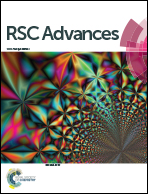On-line separation/analysis of Rhodamine B dye based on a solid-phase extraction high performance liquid chromatography self-designed device†
Abstract
A special self-designed device based on poly-1-vinyl-3-pentylimidazole hexafluorophosphate (PILs-C5) solid-phase extraction and high performance liquid chromatography (HPLC) is proposed as a novel method for the on-line separation and analysis of Rhodamine B (RhB) dye. Single factor experiment design and orthogonal experiment design were used to optimize the experimental parameters, such as pH, the amount of PILs-C5, sample volume, flow rate, eluent type, eluent concentration, eluent volume, and the flow rate of eluent. Under the optimized conditions, the linear range was 0.02–2.4 μg mL−1, with the correlation coefficients (R2) of 0.997. The limit of detection (LOD) and limit of quantification (LOQ) were 0.004 μg mL−1 and 0.02 μg mL−1, respectively. The extraction capacity was 6.22 mg g−1, and enrichment ratio was 15. The extraction mechanism and the post-treatment method of PILs-C5 were also studied. This method was applied to analyze RhB in a wide variety of real samples with satisfactory results.



 Please wait while we load your content...
Please wait while we load your content...